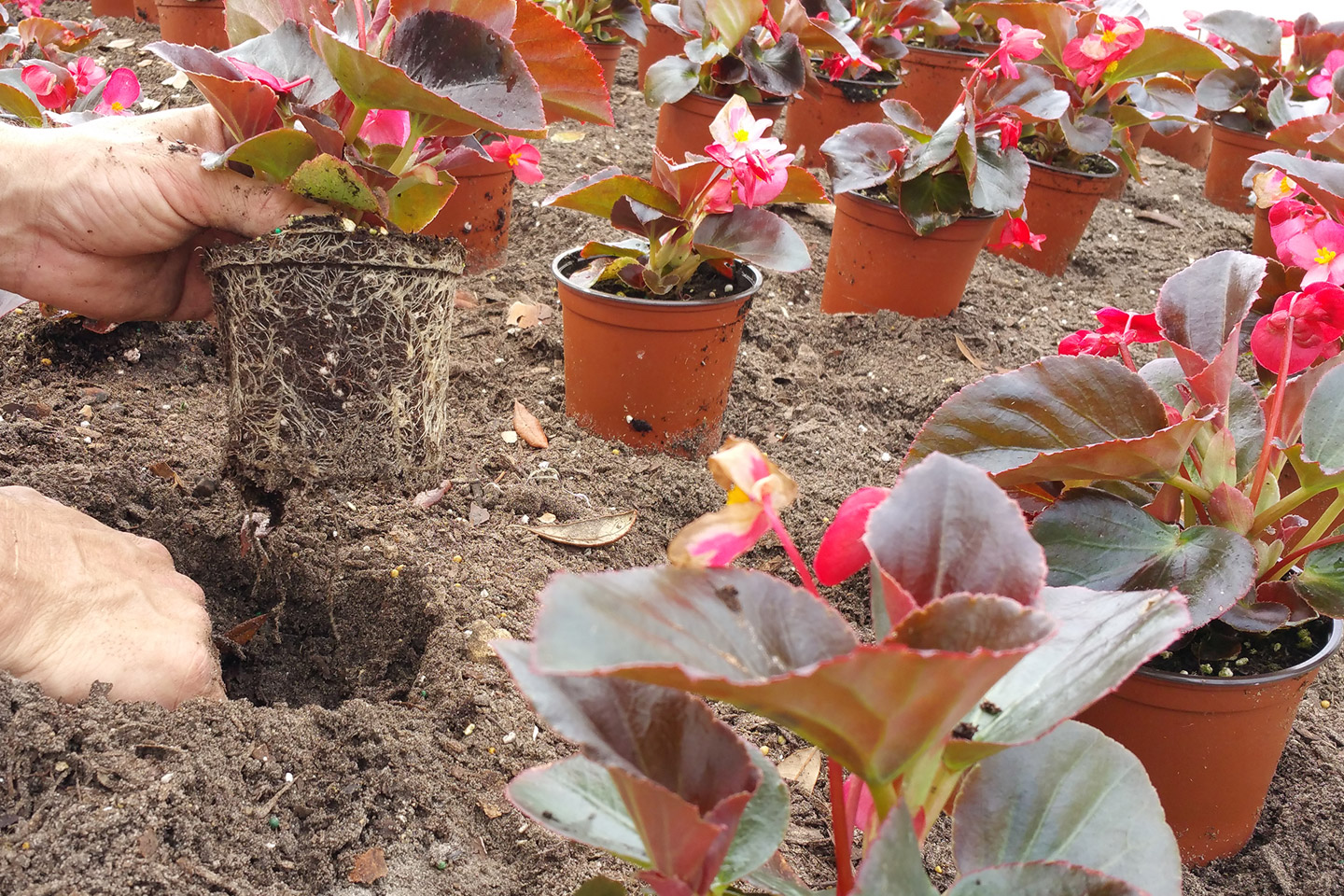Florida Turfgrass Varieties - Sit Down with CEPRA
Florida has a number of turfgrass varieties that you can choose to use in your landscape. Although it may seem rather straightforward given their ubiquity - who hasn't seen St. Augustine turfgrass in their town? - selecting the correct turfgrass for your area is critical to its success and sustainability. When beginning the process of choosing your grass, there are several key questions that you must ask yourself to make the best decision:
- What type of lawn use is desired or expected? Is it to be used in a residential setting? As a park or play area? Or used along roadways and retention ponds?
- What level of maintenance is needed? What is the expected mowing height and mowing frequency for the grass?
- Is the turfgrass prone to weeds, insects, and disease? Which ones? Can an integrated pest management (IPM) system be established?
- How often and how much fertilizer will the turfgrass require for optimum health? Are there any county ordinances, such as nitrogen blackout dates, that will impact the fertilization programs of the grass?
- How will the grass tolerate sun and shade in the landscape? Does it require a large number of hours of sunlight? Will it thrive planted under canopy trees, or between buildings?
The most common turfgrass varieties used throughout Florida are Bahia, Bermuda, Centipede, St. Augustine, and Zoysia. While Bahia, Bermuda, St. Augustine, and Zoysia are found throughout the entire state, the Centipede variety is typically only used in North Florida and along the Panhandle. Below, we will discuss each grass's main features, as well as considerations for installation.
Bahia
Bahia is a coarse-textured turfgrass that is light green in color. Examples of Bahia turf grass cultivars include 'Common,' 'Argentine,' and 'Pensacola.' Bahia's optimum mowing height is 3 - 4 inches. Bahia grass was introduced from Brazil in 1914, initially used as pasture grass, but as new varieties have been introduced, it has also become more prevalently used as a lawn grass. It can be established in the landscape by either seed or sod.
Pros: Bahia grass has an extensive, deep root system and is exceptionally drought tolerant. This grass prefers acidic, well drained, sandy soils, and thrives in full sun locations. It does not require high inputs of water or fertilizer. It has few disease and insect problems.
Cons: Bahia grass is not tolerant to full shade and has poor salt tolerance. Any type of foot or vehicular traffic will quickly damage this turf. In times of drought, the Bahia grass will go dormant until the conditions become favorable for growth. The turf will grow rapidly during the summer rainy season, generating unsightly seed heads, but then will significantly slow down growth in the fall and winter.
Use: Bahia's low nutrient requirements and affinity for sandy soils makes it a great turfgrass for a budget-friendly, low-maintenance lawn, and it is also an excellent turfgrass for lesser-used common area spaces, such as around ponds or as buffers to natural preserves.
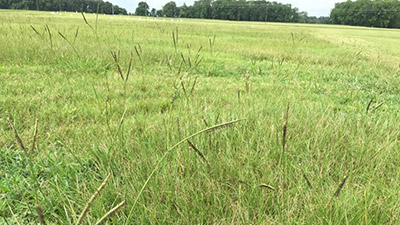
Bahia Grass in a field.
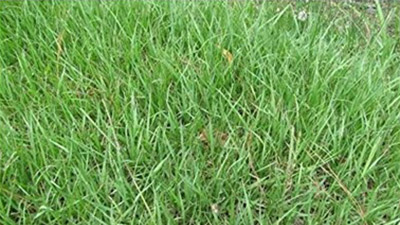
Bahia Grass up close.
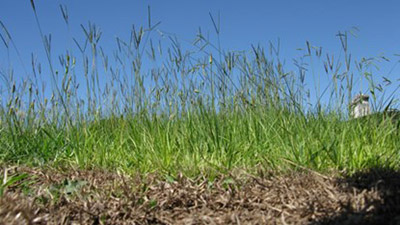
Bahia Grass with seed heads.
Bermuda
Bermuda is a fine-textured turfgrass that produces a vigorous, medium to dark green color. Examples of Bermuda turfgrass cultivars include 'Tifway,' 'Celebration,' and 'TifTuf.' This turf's mowing height is based on the cultivar chosen, although it is commonly kept at a mowing height of 0.5 - 2 inches. Bermuda grass is typically established by sod, sprigs, or plugs. This grass was introduced from Africa.
Pros: Bermuda grass handles foot traffic very well. The grass is sustainable in a wide range of soil conditions and has excellent salt tolerance. It has good drought tolerance but in times of severe drought, the grass should receive supplemental water or else the turf will go dormant.
Cons: Bermuda grass has poor shade tolerance and needs to be grown in a full-sun location for optimum long-term sustainability. The turf grass will require significant inputs of fertilizer during the growing season, making it a more high-maintenance turf. The mole cricket tends to be the most common pest of this grass.
Use: Bermuda's tolerance for traffic makes it an excellent turfgrass for athletic fields, golf courses, and gathering areas or "great lawns" in residential and commercial landscapes.
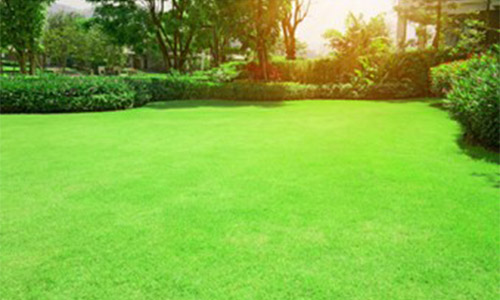
Bermuda Grass in a lawn.
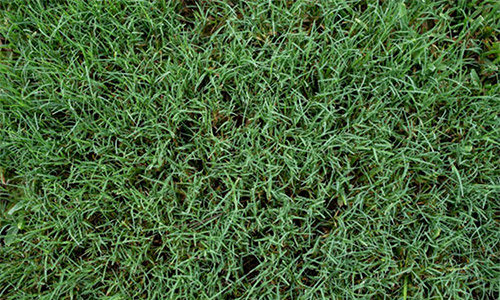
Bermuda Grass up close.
Centipede
Centipede is a coarse-textured grass that is yellow-green in color. The mowing height for this grass is typically maintained between 1.5 to 2.5 inches in height. The grass is established by seed, sod, sprigs and plugs. Originally from Asia, Centipede grass was introduced in the early 20th century.
Pros: Centipede grass is a low maintenance grass that thrives on acidic, well drained, unfertile soils mainly in North Florida and the Panhandle. This grass has a medium drought tolerance, but will require supplemental irrigation in times of severe drought. It requires a low frequency of fertilization throughout the year.
Cons: Centipede grass has some shade tolerance, but too much will cause damage. It has poor salt tolerance. The turfgrass does not handle foot traffic well and when damaged it takes a long time to recover. Disease and pest issues can plague this turfgrass at times, especially if the turf is poorly drained.
Use: Centipede's affinity for sandy soils and low nutrient needs makes it ideal as a utility turf, and it is often used alongside roadways and in common areas in the northern part of the state.
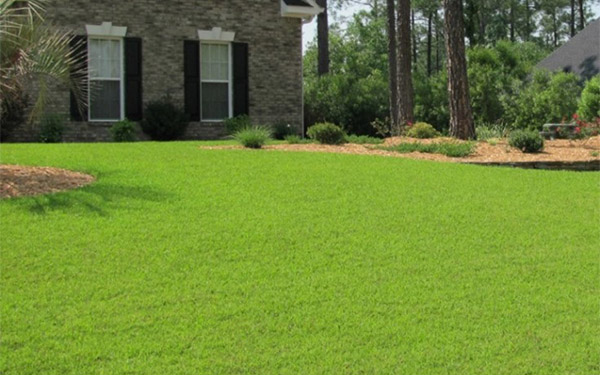
Centipede Grass in a lawn.
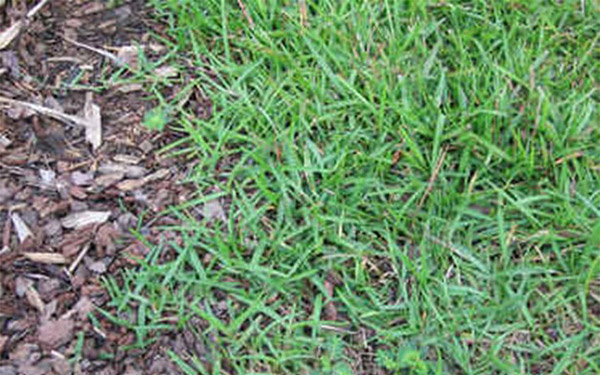
Centipede Grass up close.
St. Augustine
St. Augustine is a dense, medium-to-coarse textured grass that is green to blue-green in color. This grass is s one of the most commonly used turfgrasses in Florida. There are a variety of cultivars, which vary from sun-tolerant to shade-tolerant, as well as standard and dwarf. A few examples of the standard cultivars of St. Augustine are 'Floratam,' 'Palmeto,' and 'CitraBlue.' An example of a dwarf cultivar is 'Seville.' The mowing height ranges from 2.5 - 4.5 inches, depending on the individual cultivar. It establishes very quickly, and can be planted as sod or plugs. This grass is believed to be native to the coastal regions of the Gulf of Mexico and the Mediterranean.
Pros: St. Augustine grass has good salt tolerance, and can be sustained on a wide range of soil types. While sun/shade tolerance is cultivar dependent, the specific cultivars excel in those conditions, offering great turfgrass coverage in areas other grasses would fail to thrive. A note of caution, over time, even the "shade tolerant" cultivars will thin in dense shade - such as that which is found between homes or under thick tree canopy.
Cons: St. Augustine grass will require water to remain green, and will need supplemental irrigation in times of low rainfall and drought. This turfgrass has poor wear tolerance and does not hold up to repeated foot or vehicular traffic. It will require multiple fertilizations throughout the year. The turf's major insect pest is the southern chinch bug, which will require pesticide treatments to control. Some of the St. Augustine cultivars are also susceptible to gray leaf spot, large patch, and take-all root rot diseases.
Use: A Florida staple, St. Augustine's dense growth habit and unique texture makes it an excellent turfgrass in lawns and focal areas of both residential and commercial spaces.
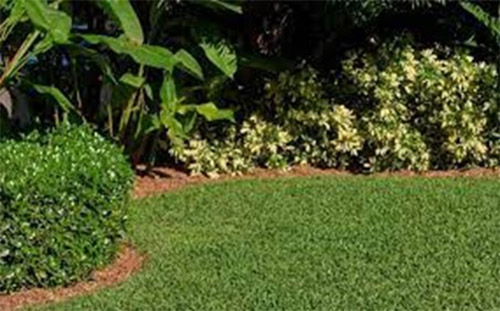
St. Augustine Grass in a landscape.
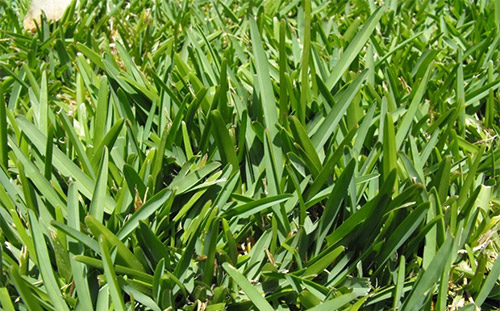
St. Augustine Grass up close.
Zoysia
Zoysia is an incredibly diverse type of turfgrass, with over 11 species of zoysia grass used in landscaping throughout the United States. The most popular cultivars in Florida include 'Empire,' 'Emerald,' and 'CitraZoy.' Its appearance ranges from fine-textured to coarse textured, and the leaf colors also vary from cultivar to cultivar. Commonly, fine-textured grasses are maintained at a mowing height shorter than coarse-textured varieties. Establishment rates also vary depending on the cultivar, and can typically be established by plugs or sod. Zoysia grass was introduced to the United States from Asia.
Pros: Zoysia grass has good salt and shade tolerance, and can be maintained in a wide range of soil types. This turf also has good tolerance wear from traffic. The grass has a medium drought tolerance and will require supplemental irrigation to remain green in times of low rainfall and drought.
Cons: Zoysia grass is considered by many to be a high maintenance turfgrass, and the upkeep can be medium to high depending upon its use in the landscape. Zoysia is the first turf grass to go off color in the fall and the last one to green up in the spring. Thatch maintenance is necessary to ensure the vigor and long-term success of the grass. When watering, zoysia does not like to be soaked; instead, it prefers a lower volume of water in more frequent, short durations. Fertilizations will be needed throughout the year to maintain optimum health. Mole crickets and white grubs can negatively affect this turfgrass. The most common disease for Zoysia is large patch, and once infected, the recovery will be slow.
Use: Zoysia's dense green appearance and excellent tolerance for traffic makes it an ideal turfgrass for residential and commercial landscapes, as well as athletic fields and golf courses.
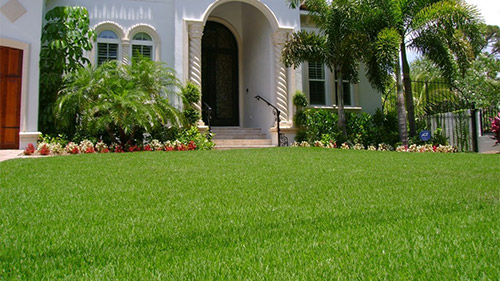
Zoysia Grass in a lawn.
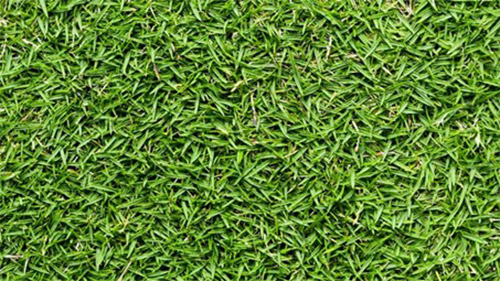
Zoysia Grass up close.
Conclusion
There are a number of turfgrass varieties to choose from for your Florida landscape. Each type has their own unique use and overall aesthetic to consider along with their pros and cons. With a wide range of cultivars available at different maintenance levels, there are many opportunities to create a beautiful and exceptional landscape that is uniquely your own.
